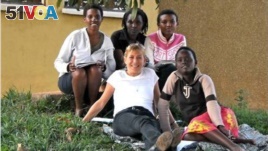March 21,2013
It’s been 19 years since the Rwandan genocide. Much has been done regarding reconciliation and rebuilding. But the work continues, including helping those who became orphans during and after the mass killings. At a youth village in Rwanda, more than 100 high school seniors, all orphans, recently passed their national exams to graduate.
It’s called Agahozo-Shalom Youth Village. The name is a combination of Kinyarwanda and Hebrew -- Agahozo meaning “where tears are dried” and Shalom meaning “peace.”
Anne Heyman, the founder, said, “I actually was attending a lecture on genocide, and there was a speaker speaking about the Rwandan genocide. This is in the fall of 2005. My husband asked him what was the biggest problem facing Rwanda today? And he said in a country where you have 1.2 million orphans, with a population of 8.5 million people, there really is no future for the country unless you come up with a sustainable solution to the orphan problem.”
Heyman is a South African born lawyer, who now lives in New York City.

Anne Heyman with some of the youth village residents. Credit: ASYV
“It occurred to me that Israel had had an orphan problem after the Holocaust, and they had come up with a system that reintegrated those kids into society, and they don’t have an orphan problem today. So there really is a systemic solution to dealing with the orphan problem,” she said.
Agahozo-Shalom Youth Village is about an hour’s drive east of Kigali, near the town of Rwamagana. It’s built on land Heywood and supporters purchased from local landowners.
“The philosophy and methodology that are infused in living in the youth village are really geared so that the village as a whole can provide parenting for each kid, even though it’s done, sort of, on a mass scale. We have 500 kids in the village. Everyone gets the kind of support that you or I would give our biological children. Yes, they get food, clothing, shelter and all those things. We’re a high school age community. So, we have a high school where kids really get a top notch state-of-the-art education,” she said.
It’s the Liquidnet Family High School, where all but one of the 118 qualifying seniors passed Rwanda’s national exams a few months ago. It’s the school’s first graduating class. The students are now waiting to see who might get a scholarship or have access to student loans. Those who don’t would have to delay university classes unless they get a job and save some money.
“All of our kids are orphans. So they’ve all gone through some traumatic episode, otherwise, they wouldn’t be orphans. We take the most vulnerable kids in the country. We focus on, as we would do with our own kids, trying to heal their emotional scars; giving them a healthy outlook on life; helping them determine what they want to do with their futures. Our goal is really not to send kids to universities. It’s to help every child maximize their potential. So they’re really looked at as individuals,” said Heyman.
Families consist of 16 youths, along with so-called brothers or sisters, who work at the village. And each family is headed by a mom.
“It’s a staff position at Agahozo-Shalom. We have 32 homes. Each home has a mom. Many of them, the vast majority of them, are women who lost their families during the genocide. And for them, too, the village is a very healing environment. They all say that they have found incredible meaning in their lives and restoring the rhythm of life for these young kids has really been incredibly uplifting for them,” she said.
Each night, there’s family time. For about an hour, members of each family get together to discuss the days events, issues in the village or new information about some sensitive issue.
Heyman said, “Some of our kids are out on the street when we get them. Some of them have drug addictions. Some of them have alcohol addiction. So we have programs for those kids. We have a very serious HIV/AIDS education program. We really work hard at it until every kid who comes through our gate gets tested so that we can deal with whatever we find.”
There are also classes on job skills, such as writing resumes or conducting interviews, and classes on hospitality, computers and modern agriculture.
Heyman said that funding comes mostly from donations and much time is spent drumming up support. She hopes to one day turn Agahozo-Shalom into a self-sufficient village, where small businesses can fund operations.
“If we can fix that last loop, making it self-sustaining in terms of income, then I think we have a tremendous model for development for the world.”
Agahozo-Shalom Youth Village has a statement of philosophy. It reads in part: Each traumatized youth has a past, present and future. Trauma causes a break between the past and present.” Heyman says life in the village is about repair.